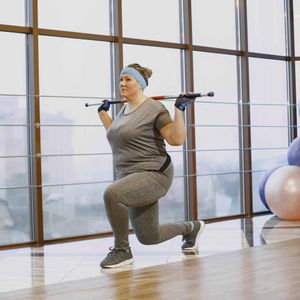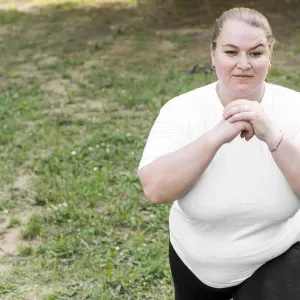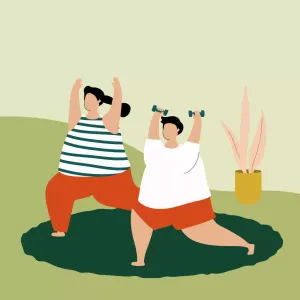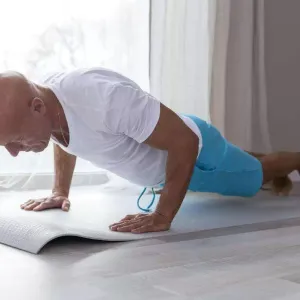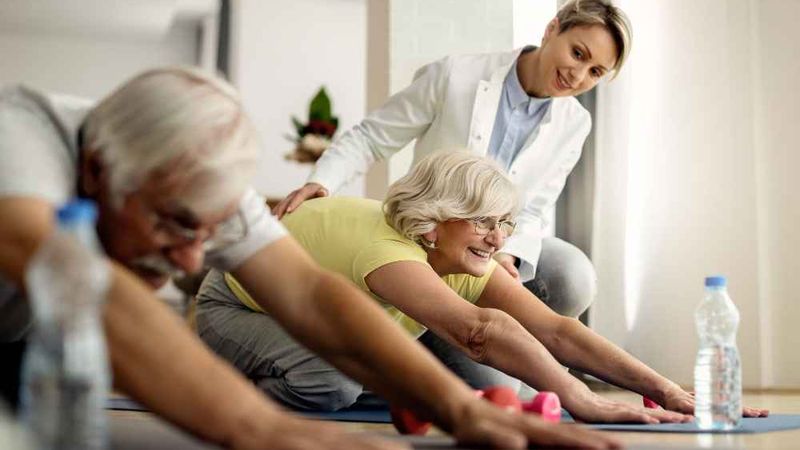

Our Review Process
Our articles undergo extensive medical review by board-certified practitioners to confirm that all factual inferences with respect to medical conditions, symptoms, treatments, and protocols are legitimate, canonical, and adhere to current guidelines and the latest discoveries. Read more.
Our Editorial Team
Shifa Fatima, MSc.
Author
Dr. Apoorva T, MHM.
MEDICAL ADVISOR
Exercises for Seniors at Home
Why is exercising important for seniors? This question can have a multi-faceted answer. Regular physical activity is very important for people of all ages – even children are, therefore, asked to join sports and such activities for all-around growth and holistic development. Similarly, even for seniors, basic exercises and physical activity can play a huge role in the overall betterment of health, dealing with health issues, and gaining strength. Some would say that exercise is even more critical for seniors as it can help them not only physically but also mentally and make them more aware, adept, and independent
Regular physical activity is proven to play a major role even in their recovery process from certain illnesses and injuries. This also helps to improve their well-being. Countless studies have noted the impact that physical exercises have created in the betterment of health. Some of the important benefits of exercise for senior citizens at home are:
- Prevention of diseases – Research has proven that maintaining a regular exercise routine by keeping physical activities intact has played a role in the prevention of common diseases like heart-related issues, diabetes, etc. Since exercise improves overall immune function, it is important for seniors as their immune system is often compromised. Even light exercise is known to be effective in the management and prevention of diseases.
- Better mental health – The mental health benefits of exercising are endless. Therapists recommend their clients to exercise daily as it results in the release of endorphins that counteracts the effects of other stress hormones. Exercise can help you feel satisfied and it is also linked to improved sleep which is beneficial for seniors.
- Lower risk of falls – Older adults are at a higher risk of falls which can only be disastrous given their age and wish to be independent. Since exercise improves strength and flexibility, along with balance and coordination, it can reduce the risk of falls.
- Social interactions – When you are exercising, you can do so as a group. Being an active member of a walking group, yoga group, fitness center, gardening club, etc can make you more socially active. Stronger social ties in old age can add to a sense of purpose and avoid feeling lonely, isolated, or depressed.
- Better cognitive functioning – Regular physical activities have also been linked to better motor skills and cognitive improvement. Research conducted across the globe has linked exercising to the reduced risk of dementia, loss of memory, etc.
Senior exercises at home have slowly gained precedence in recent years wherein diseases and the impact they are creating have increased. The need to be physically fit and healthy is something that a person of no age should ignore. These activities need not be conducted for a long duration. 30-40 minutes per day, even divided into parts will do the job.
Table of Contents
Challenges faced by Seniors
There is a reason why senior citizens often find it difficult to follow an exercise routine and are, therefore, not able to do it regularly. Certain mental barriers like – the fear of falling, tearing a ligament, soreness and pain, lack of motivation, unwillingness to leave the comfort, etc are some of the reasons why they may keep procrastinating engaging in physical activities. Mental barriers, however, are just a part of the reason that may pose a challenge to the regular following of an exercise routine. Along with these, there can be actual physical issues that they may be facing that lead a person to feel like they would not want to engage in exercises.
- One of the most common challenges faced by seniors, even if they wanted to stay active, would be overall low mobility. To counter this, they can engage in low-impact exercises that will slowly help their bodies loosen up and will have increased their strength, and gain more mobility overall. Here, the important thing to consider would be to ensure that these activities are designed for their comfort and are safe to conduct. This will be even more vital if they are exercising on their own.
- High-intensity workouts are not suited for most seniors. Easing into regular exercising or yoga can be a good way to transition into this pattern that can help them remain healthy. This will also reduce their chances of overdoing it in terms of workouts.
- Another barrier would be going to a gym or a facility to exercise. Many older adults are homebound and may not have anyone to accompany them outside. They may need a set of exercises that they can do at home. Here, helping them with a list of senior citizen exercises at home can help them be active and achieve their goals. Even if they are unable to leave home, these light exercises can help significantly.
- Health concerns pose another threat to the regularity of working out for seniors. Since many of the geriatric population are diagnosed with several medical health issues like diabetes, high cholesterol, blood pressure, heart conditions, etc, they may not be allowed to engage freely in certain types of exercises. Therefore, it would be potent to ensure that the workout regime that they have is fitting for their specific underlying issues. Using a heart rate test or checking blood sugar levels before and after working out can be helpful. This is a good way to ensure that they understand their limitations regarding working out and can develop a routine that fits their needs and capabilities.
Top 10 exercises for seniors at home
If you are looking for options for exercise for older adults at home, these can be some of the most beneficial activities. They vary in their overall physical training level and you can pick and choose the ones you feel will work best for your loved ones
1. Cycling
Cycling is one of the best exercises that an aging body can engage in. It helps with the overall cardiovascular system to promote better heart health. It also does not put excessive strain on the joints as it is a low-impact activity. Cycling is also known to promote better brain health and it is easily accessible as it can also be done at home with a stationary bike.
2. Weight training
Light strength training for seniors at home can help with the prevention of osteoporosis and increase muscle strength. Simple exercises with the help of a resistance band or using body weight can enhance strength and endurance. 2 sets of about 10 repetitions can also be enough to improve muscle mass. You can also use light weights or water bottles to help you with these exercises.
3. Low-impact exercises
Low-impact exercises could be gardening, strolling, light cleaning, etc in the house. These can help the muscles in the body get activated and used to the movement. The impact can gradually be increased as per the person’s requirements and strength for more benefits
4. Walking
This is one of the easiest exercises for older adults and one that they enjoy a lot. Walking with music alone or as a group will help too. Going to a garden, terrace, or even brisk walking at home may help. In case the person has an unsteady balance, make sure that they are accompanied by another person to reduce the risk of falling. Walking improves cardiovascular health and lowers stress and blood pressure.
5. Leg raises
Yet another simple but effective activity for seniors to engage in at home would be leg raises. This exercise improves leg strength and can also promote better balance. You can also conduct this activity using a chair to hold on to for balance. These exercises can help older adults gain more muscle mass in their legs and feet.
6. Arm raises
Similar to leg raises, arm raises can also be effectively done at home while sitting or standing. You can also use small weights to help you even more with the exercise to increase strength. This is a short activity that can be done every day even while watching television. It can help improve the overall range of motion in the arm
7. Shoulder rolls
Another effective yet easy exercise for seniors would be shoulder rolls. This will make them more independent as they will be able to lift things with more ease without experiencing much pain. Rolling the shoulders forwards and backward will help maintain the best possible range of motion. Make sure that this exercise does not aggravate any other injury.
8. Toe lifts
An excellent way for adults to practice balance and strengthen their feet to improve mobility would be toe raises. Hold the back of a chair and stand on your toes before lowering back down. You can also build balance by holding the chair with one hand or not using a chair at all. Do this only if you are confident of no possibility of injury.
9. Stretching exercises
Stretching different body parts including hands and fingers can help loosen the muscles and make the activity easier. It can also help relieve any kind of chronic pain. Stretching is also known to increase flexibility. You can isolate certain muscle groups in the body and gently pull. Be careful when you stretch your hips and knees.
10. Yoga
Yoga comes under the top 10 balance exercises for seniors at home and it has a positive impact on physical and mental health. It uses a combination of light movements, stretching, breathing, and meditation to activate the body, its cells, and its muscles. Yoga can be beneficial for specific ailments as well. It can be done at home for 30-40 minutes and significant changes can be seen with regular practice.
These are some of the most effective and recommended activities for seniors to engage in at home. These can be done as frequently as comfortable and the duration can increase gradually if needed
Bottomline
The benefits of exercising are underrated for senior citizens even though multiple studies have proven how advantageous they can be. Even minimal and lighter forms of exercise can play a significant role in the overall betterment of mental and physical health. It can prevent complications and can help manage the symptoms of the issues that the person is dealing with. Letting go of the sedentary lifestyle and regular walking, cycling, yoga, stretching, or any other form of exercise that a senior person is comfortable with can be added to the routine. Finding exercises for seniors to do at home under the supervision of an expert with the approval of their doctors would be the ideal plan. This will also help prevent any unwanted issues or injuries that they might face.

FAQs
What exercise should a 70-year-old be doing?
Seniors who are above the age of 70 can engage in lighter and moderate forms of exercise depending on their physical factors like mobility, pains, comorbidities, doctor recommendations, etc. Usually, walking, brisk walking, yoga, stretching, etc are often safe for the older population. Some people are also comfortable with strength training with the help of resistance bands to gain more power in their muscles.
What is the best time of day for seniors to exercise?
The best time of the day to work out for seniors at home would be the time that they find convenient. Most seniors have an early alarm clock which will make morning times more suited, however, others would want their house help to be with them while they engage in these activities and would prefer to do so in the afternoon or early evening.
Does housework count as exercise?
With a few considerations in mind, home chores can also count as a great form of exercise. Working around the house can be tiring and can burn calories and tone muscles. However, senior citizens may not engage in active household work. Before engaging in active physical exercises, senior citizens can start slowly with specific household tasks and then expand their range to more strenuous activities
References
- https://www.healthline.com/health/everyday-fitness/senior-workouts#balance
- https://www.lifeline.ca/en/resources/14-exercises-for-seniors-to-improve-strength-and-balance/
- https://www.today.com/health/diet-fitness/best-exercises-for-seniors-rcna49137
Disclaimer
This website's content is provided only for educational reasons and is not meant to be a replacement for professional medical advice. Due to individual differences, the reader should contact their physician to decide whether the material is applicable to their case.





